A comprehensive, step-by-step pictured tutorial on How to Make Sauerkraut that is incredibly healthy and delicious! Making your own fermented homemade sauerkraut is super easy, requires minimal prep work, and the rest is just a waiting game. This Sauerkraut recipe covers everything you need to know to ensure your success!
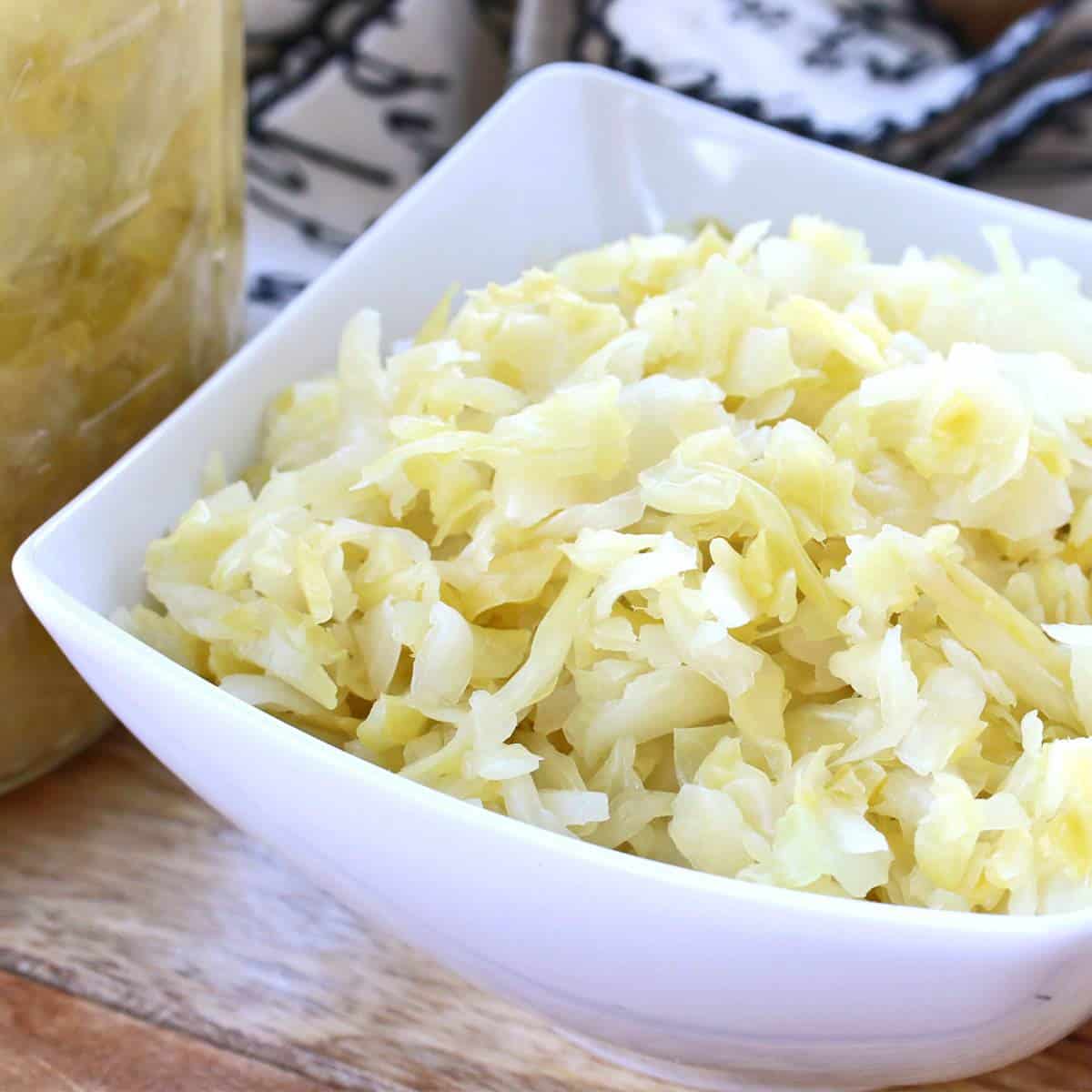
Sauerkraut is in my blood. Being from Germany and raised by a health-conscious mom, I ate this stuff on a regular basis. In Germany sauerkraut is eaten fresh or cooked in a wide variety of dishes; everything from casseroles and soups to salads or alongside meats and sausages. Raw fermented sauerkraut was always readily available in our local health food stores. My mom and I regularly went to our local Reformhaus and in the refrigerated section was a large vat of fresh sauerkraut where we could scoop out as little or as much as we wanted into the bags provided. We’d often nibble on some of it as we made our way through the outdoor shopping district and then take the rest home with us. This ancient skill has been making a comeback in recent years both overseas and in the U.S., with a growing number of people learning how to ferment their own foods.
I’ve been fermenting vegetables, grains, legumes, and dairy products for over a decade and it is a deeply satisfying venture. If you’ve been curious about how to make sauerkraut it’s time to make that leap.
For anyone interested in trying their hand at fermentation, sauerkraut is the perfect place to start!
Why Make Your Own Sauerkraut?
The benefits of probiotics are well-established and the fact that you’re here reading this means you’re already aware of that. And you’re probably also aware that there is no better or easier way to access a wide spectrum of probiotics than making your own sauerkraut. With probiotic supplements you’re limited to a couple or few select strains. Research has shown homemade fermented sauerkraut to contain as many as 28 separate and distinct strains. No probiotic pill can replicate that. Not to mention that there is no way to verify how much of the bacteria is even still alive in probiotic supplements.
With homemade fermented sauerkraut you’re benefitting not only from a large variety of probiotic strains, you’re also getting a large dose of live, healthy, and robust ones.
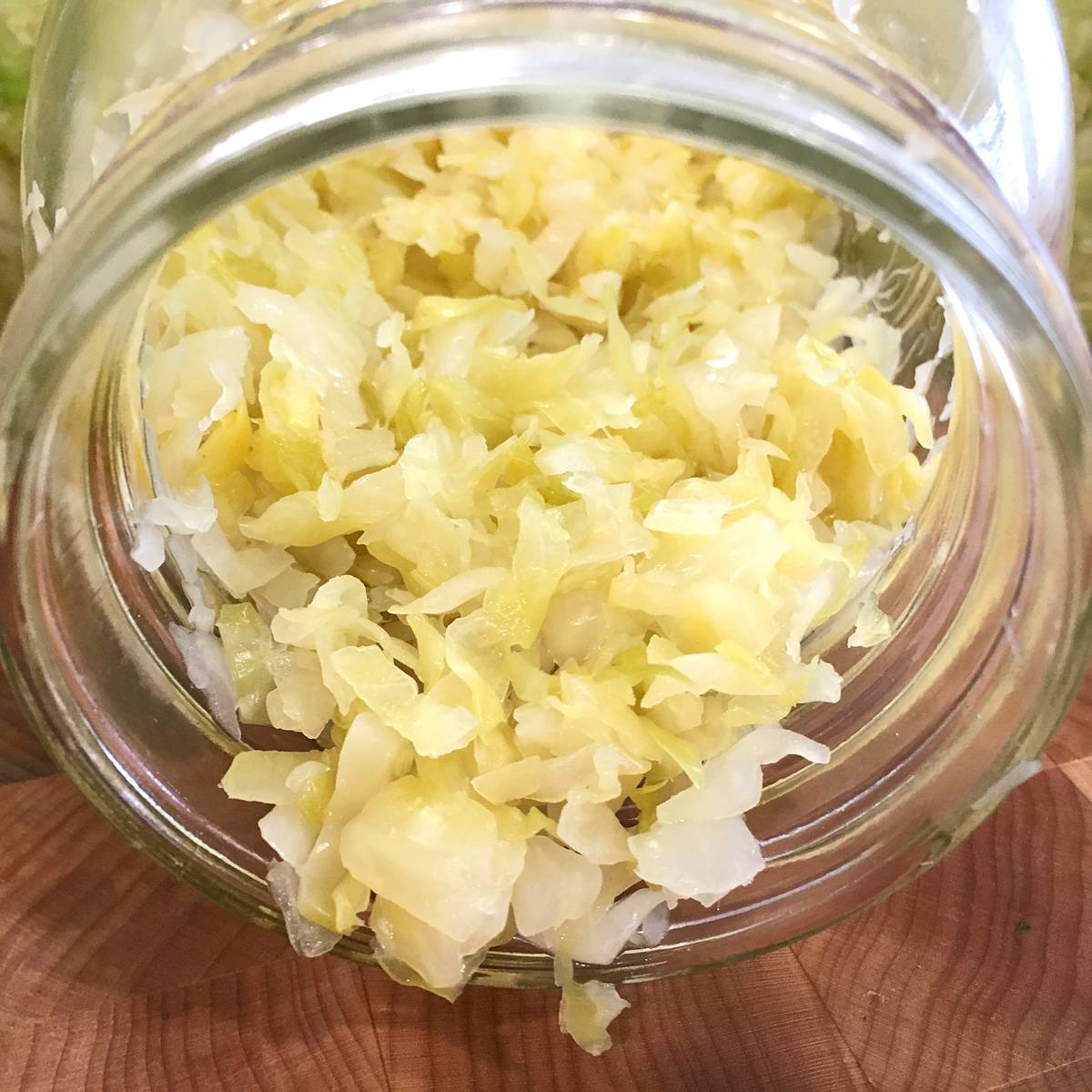
What Equipment Do I Need to Make Sauerkraut?
You don’t need any specialized equipment to make sauerkraut.
- A large glass or ceramic jar (I regularly use half gallon Mason jars)
- Some kind of heavy, flat-bottomed tamper for crushing the cabbage
- Something flat to weigh down the cabbage that’s relatively close in size to the diameter of the jar you’re using
- Fresh cabbage
- Salt (sea salt or kosher salt)
That’s it. You don’t need any specialized tools, gadgets, or equipment. People have been successfully making sauerkraut for many centuries using the most basic supplies and chances are you already have what you need on hand and can easily improvise if you need to.
Specialized Sauerkraut Making Equipment (Optional)
Alternatively you can invest in some dedicated equipment, some of which (airlock lids) will make the process more maintenance-free:
- Airlock lids – These lids prevent mold spores/yeasts from getting into the jar so that you don’t have to monitor it as closely or remove mold as it forms. They also automatically release air pressure as the veggies ferment so you don’t have to manually open the jar on a daily basis to release the pressure.
- Sauerkraut Crocks – These come in all difference sizes depending how large of batches you’re making. Some crocks come in a kit with a tamper and weight.
- Sauerkraut Tamper/Pounder – You can find these in wood or stainless steel and they allow you to pound the cabbage to release its liquid and then use it as a tamper for stuffing the cabbing in the jars.
Additional Resources
- The Art of Fermentation by Sandor Ellix Katz – The ultimate guide to fermenting anything and everything, including sauerkraut. It’s my favorite book on the subject and the one I most highly recommend.
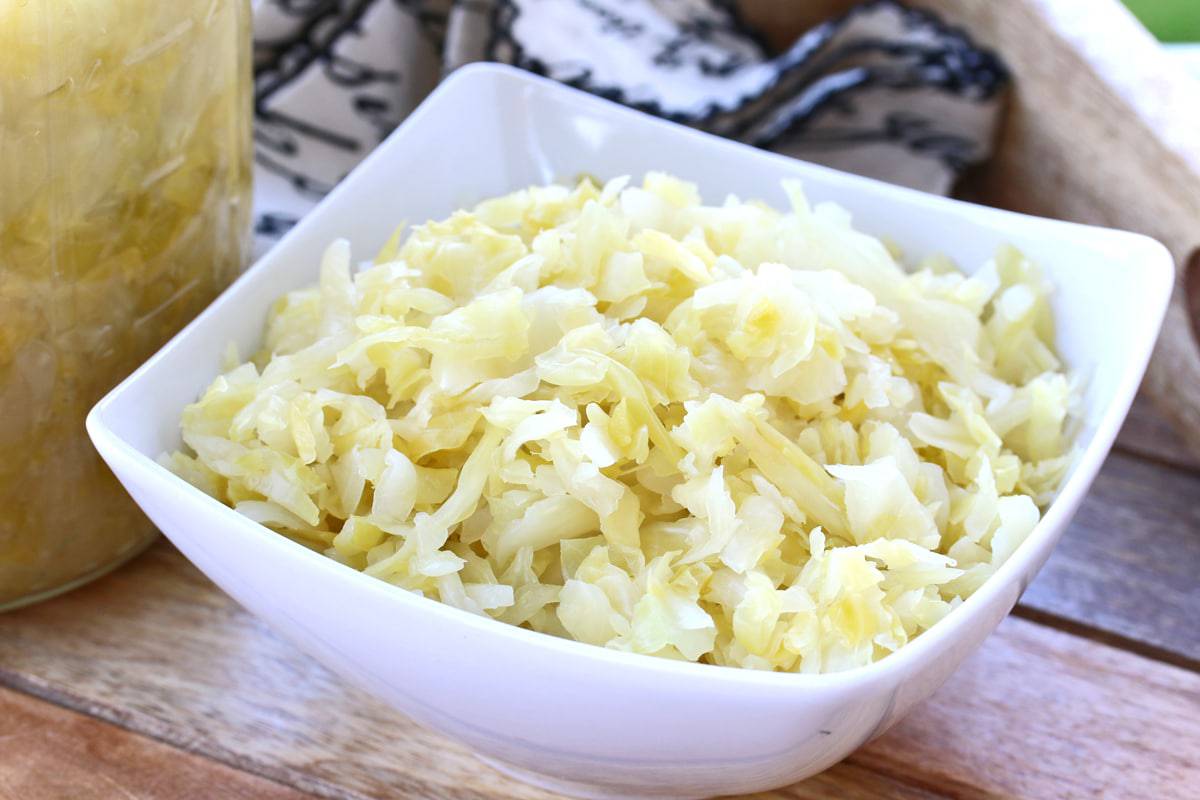
How Long Does Sauerkraut Keep?
Stored in a dark, cool place it will keep for many months. The cooler the storage area the longer it will keep. I keep mine stored in the fridge. Even in a cold environment like the fridge, sauerkraut will continue to ferment though at a much slower pace.
Can You Freeze Sauerkraut?
Yes, but just know that it will kill the probiotics. Cooking the sauerkraut will also kill the probiotics. So if your objective is to reap the benefits of the probiotics, eat it raw and unfrozen. If your objective is simply to enjoy it cooked as a delicious food (and delicious it is!), you will still reap the benefits of its vitamins and fiber.
How Long Does it Take to Ferment Sauerkraut?
As long as you want it to until it reaches the desired texture and level of tanginess. Days. Weeks. Months. It will become tangier the longer it sits.
The length of the fermentation time will depend primarily on the temperature of the environment. The cooler the environment, the longer it will take to ferment. The warmer the environment the quicker it will ferment, the flavor will be inferior, and the sauerkraut is at greater risk of developing unwanted yeast and going bad. The ideal temperature for sauerkraut is 65-70 F. At that temperature we recommend letting it ferment for at least 2 weeks (preferably longer) but you can cut it shorter depending on your taste preference.
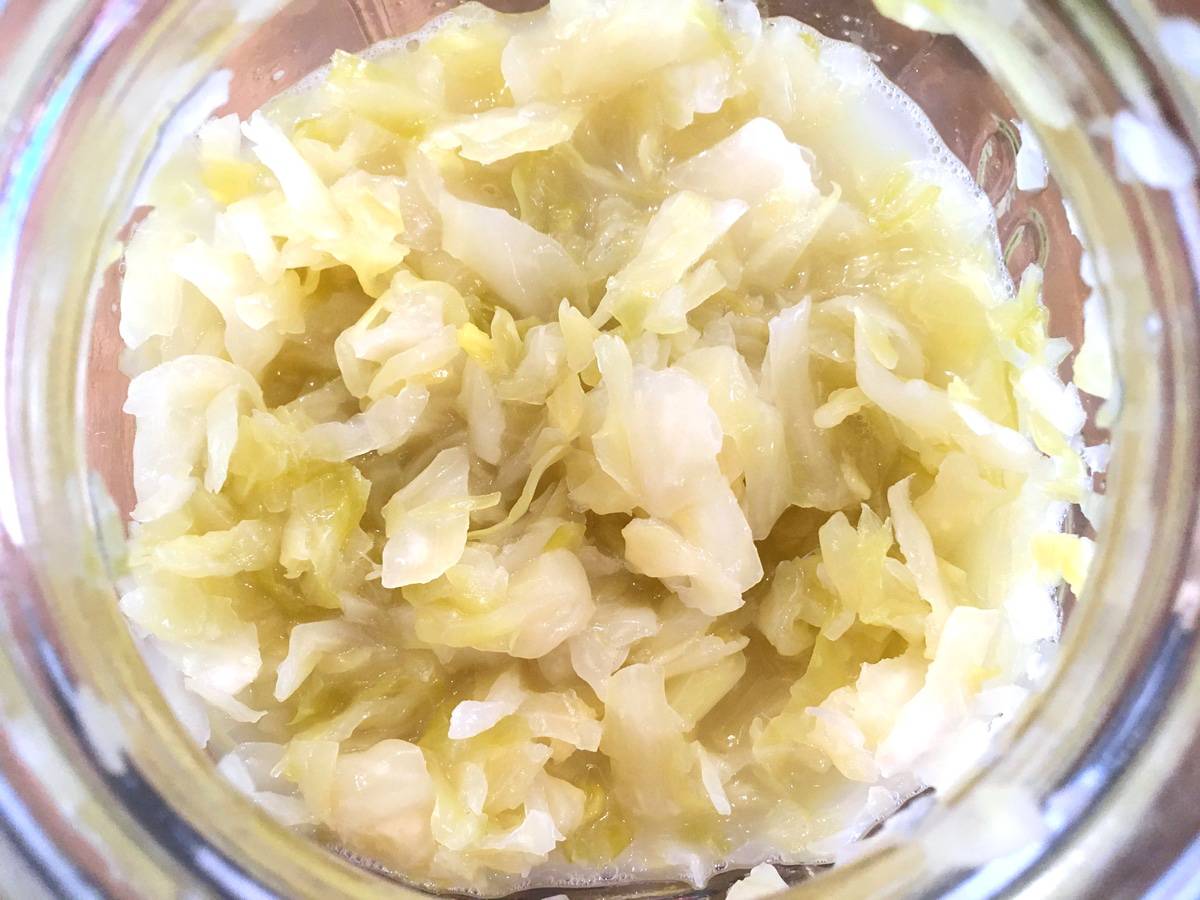
Can I Make Sauerkraut Without Salt?
While you can make sauerkraut without salt and you can find information on alternatives online, we do not recommend it. Salt is a key ingredient in fermenting foods for several reasons: 1) It creates an environment that favors the formation of lactobacillus bacteria (good bacteria) and prevents unwanted bacteria and yeast from forming, 2) It prolongs the shelf-life, 3) It helps preserve the vitamin and mineral content of the food, 4) It improves the flavor, 5) It helps keep the vegetables crisp and crunchy, and 6) It slows down the fermentation process so that the vegetables can develop a fuller, more complex flavor.
Fermented vegetables, including cabbage, do best with a salt content of 2-3%. Translated in measurements that’s 1 1/2 to 2 teaspoons of salt per pound of cabbage (9-12 grams of salt per 450 grams of cabbage).
Does Sauerkraut Go Bad?
While fermented foods are slower to go bad, they most certainly can and will in time. So how can you tell if sauerkraut is bad? See below.
My Sauerkraut Has Mold on it: Is it Safe to Eat?
In most cases it is perfectly safe. Mold most often occurs when the cabbage isn’t submerged under the brine and comes in contact with air. When this happens it is perfectly safe to remove and discard the top layer of the sauerkraut. This is true if the mold is a greenish or grayish color. If however the mold is black, orange, or pink or if your sauerkraut has changed to an unpleasant color, slimy texture, or bad smell, then toss it.
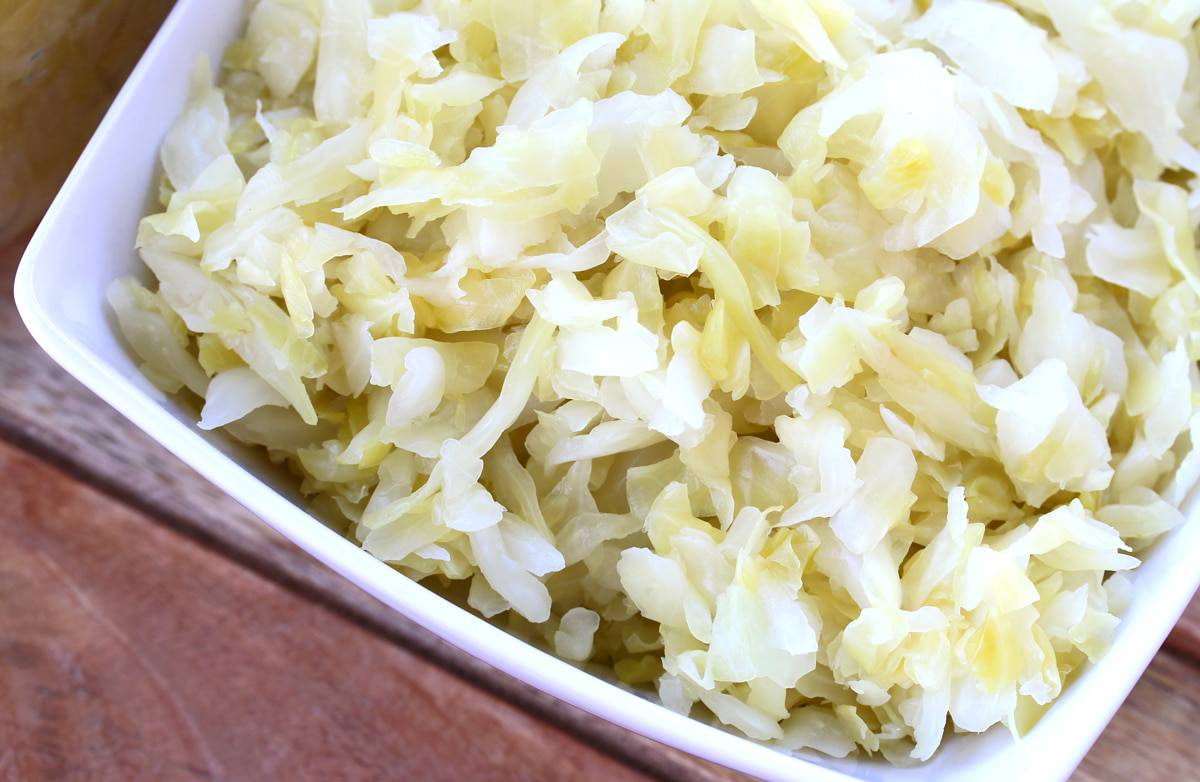
How to Make Sauerkraut
Here a summary of the basic steps and below I’ll take you through those steps in detail:
- Chop the cabbage and place it in a large flat-bottomed bowl.
- Salt the cabbage.
- Pound the cabbage to release its juices.
- Transfer the cabbage to a glass or ceramic jar or crock and use a tamper to push the cabbage down into the jar to remove any air pockets until the cabbage is completely submerged under the brine.
- Place the lid on the jar, put the jar in a cool, dark place, and wait. Remove the lid every day to release air pressure, to make sure the sauerkraut is submerged under the brine.
- Taste the sauerkraut every day after the first few days until it reaches the desired texture and level of tanginess.
- Screw the lid on tight and store your finished sauerkraut in the fridge or a cool cellar.
Let’s get started!
Prepare the Cabbage:
Remove any bruised or damaged exterior leaves from the cabbage, then cut the cabbage in half and remove the core. Slice the cabbage very thinly, approximately 1/8 inch thick. For the best texture we recommend slicing it very thinly by hand, not with a food processor. You can slice it by hand, use a mandolin, or cabbage slicer.
Place the sliced cabbage in a large bowl and toss in the salt. Let it sit for about 20 minutes until the cabbage has begun to wilt and releases some of its juices. Use a tamper/pounder to crush the cabbage until it is wilted and has released a lot of liquid. This will take several minutes.
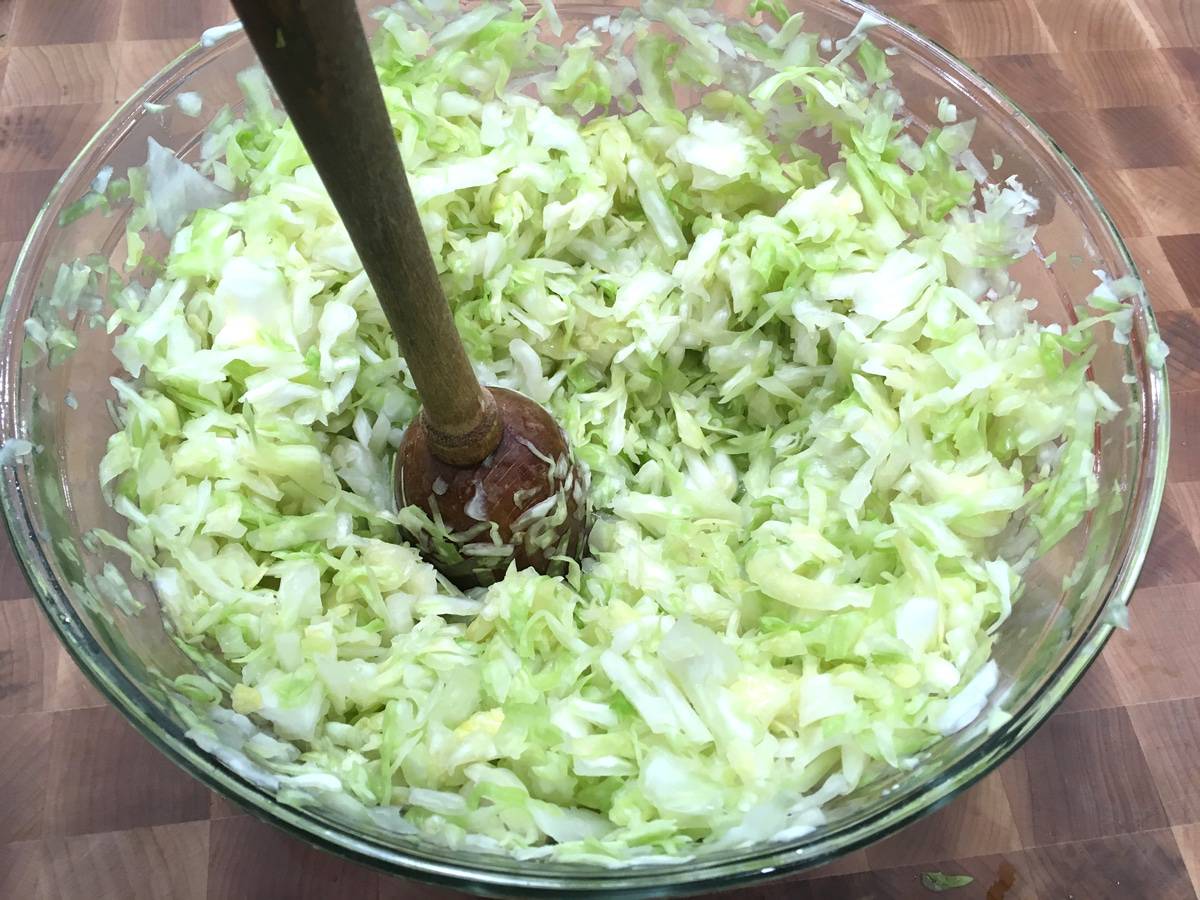
Pack the Cabbage into a Jar or Crock:
Transfer the cabbage and all the juices to a glass or ceramic jar or crock a bit at a time and mash it down with a tamper. Fill the jar to about 2/3 full (the cabbage will bubble as it ferments and could overflow if the jar is too full).
Continue to mash the cabbage with the tamper, releasing more juice, until the cabbage is completely submerged under the brine.
If you’ve mashed all you can mash and you still don’t have enough brine to cover the cabbage you’ll need to make some supplemental liquid that is consistent with the salinity of the cabbage brine: Dissolve 1 teaspoon of salt in 1 cup of water (a 2% salt water solution) and add that to the jar until the cabbage is completely submerged under the liquid.
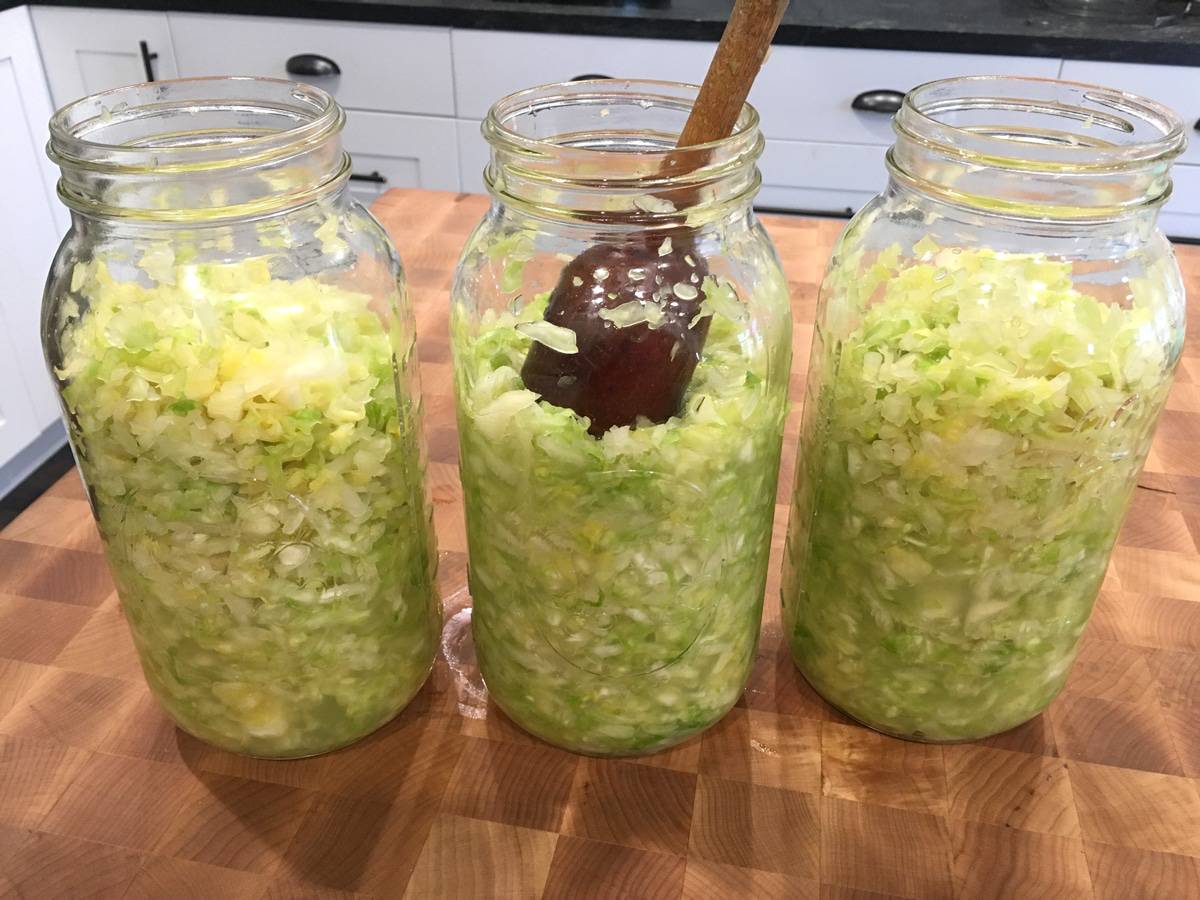
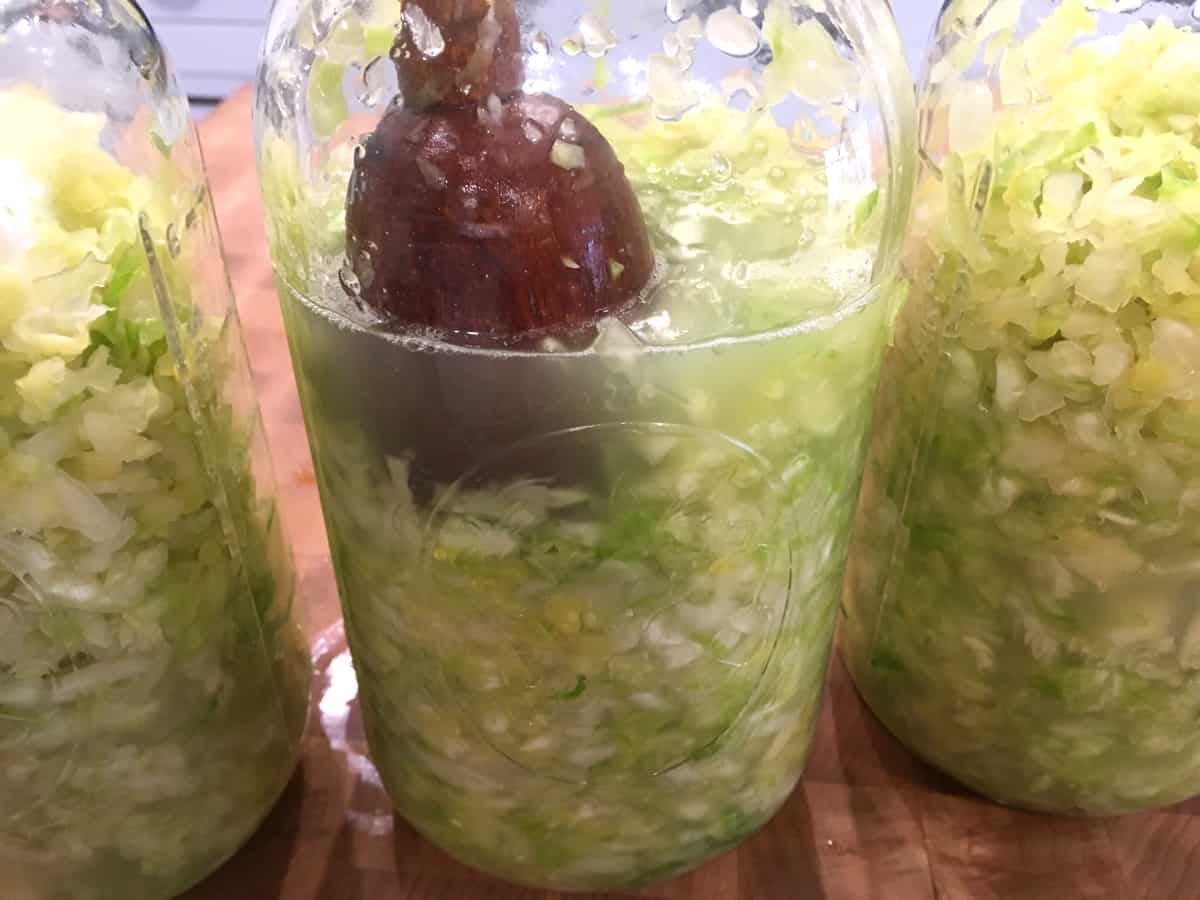
It’s also important to mash the cabbage to remove any air pockets in order to prevent mold growth.
The prep work is done.
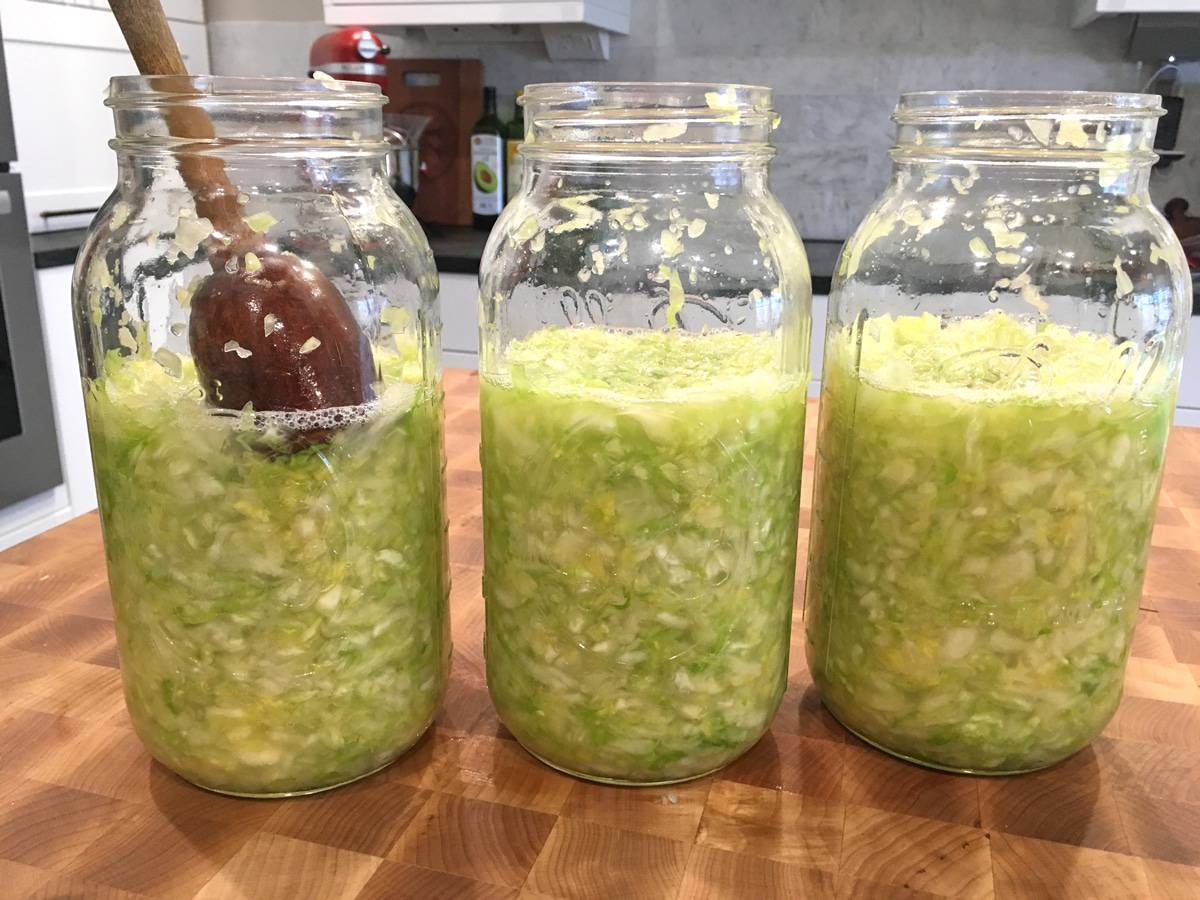
It is imperative that the cabbage remain submerged under the brine during fermentation, otherwise mold will form (See section above “My Sauerkraut Has Mold on it: Is it Safe to Eat?”). To do this choose a heavy object whose diameter is roughly the same size to the inside of the crock you’re using. The object should be glass, ceramic, or non-reactive metal.
Note: I have made sauerkraut multiples times in large mason jars (usually 1/2 gallon size) without needing to use weights. Because of the small diameter of the jar, after a day or two of fermenting the cabbage usually remains below the liquid level. If the cabbage rises above it I just mash it back down with the tamper. If you choose to use mason jars without using something to weigh down the cabbage, just be sure to keep a close eye on it each day throughout the fermentation process.
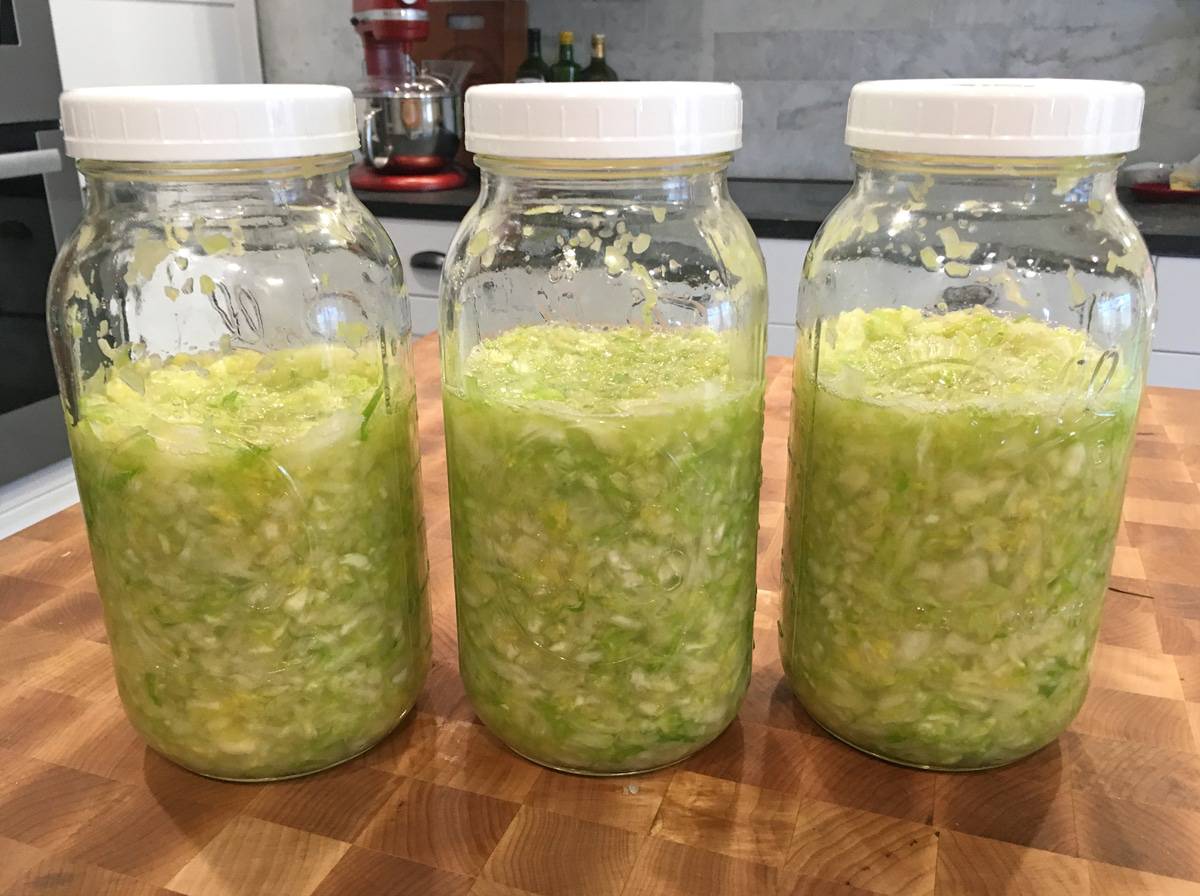
Let the Fermentation Begin!
Screw on the lids to fingertip tightness. If using airlock lids, follow the instructions provided with your lids.
Place the jars in a dark place that is between 65-70 degrees F, the ideal temperature for fermenting. (See section above “How Long Does it Take to Ferment Sauerkraut” for information on temperature variations.)
Now it’s time to WAIT.
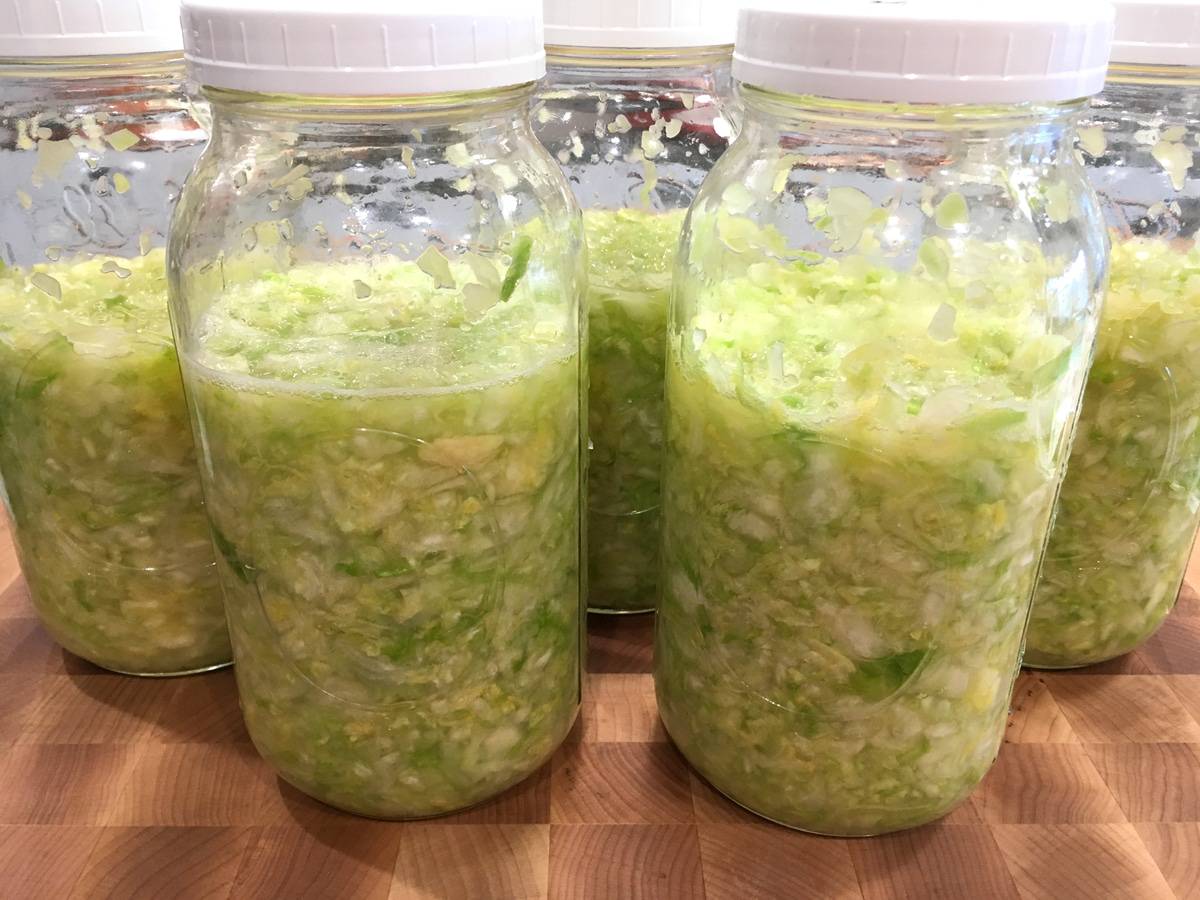
At a the ideal temperature range of 65-70 F we recommend fermenting the cabbage for at least 2 weeks (we recommend longer) but follow your own taste.
After 4 days of fermenting start tasting the cabbage daily until it reaches the desired texture and level of tanginess. Don’t be alarmed if the brine becomes fizzy, this is completely normal and a positive sign of microbial activity.
The color of the cabbage will change from green to a pale yellowish beige (in the pic below compare the green-colored cabbage in the jars, still in the early stages of fermenting, with the finished sauerkraut in the middle).
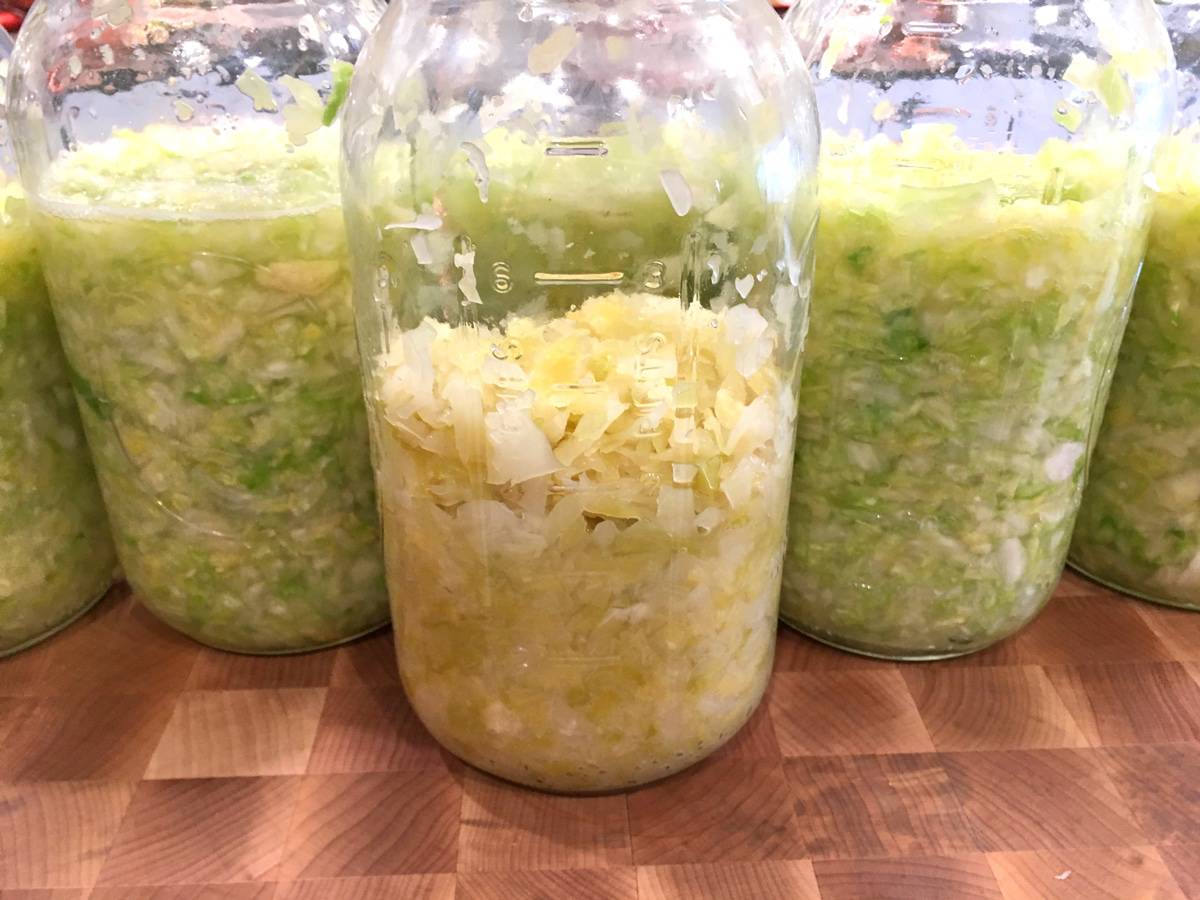
Once your sauerkraut has reached the level of tanginess that you want, it’s time to screw the lid on tight (remove the airlock lid if using and replace it with a regular lid).
Store the sauerkraut in the fridge or a cold cellar. The storage temp should be between 38-50 degrees F. Fermentation won’t stop but it will be greatly slowed down.
Stored in the fridge the sauerkraut will keep for many months. (See section above “Does Sauerkraut Go Bad?”) If your sauerkraut is too salty for your taste simply give it a rinse before eating.
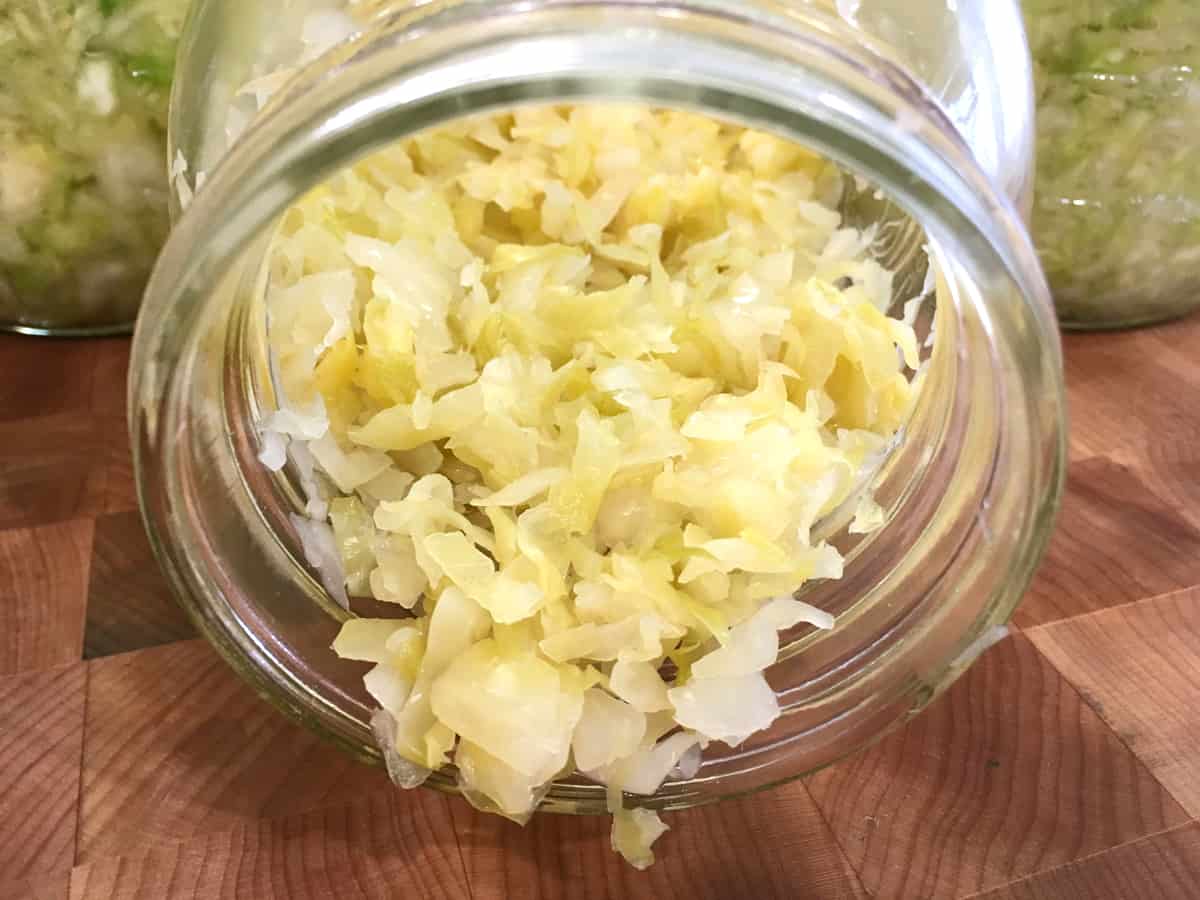
Eat your sauerkraut raw to reap the benefits of the probiotics or use it in any recipe calling for sauerkraut.
Enjoy!
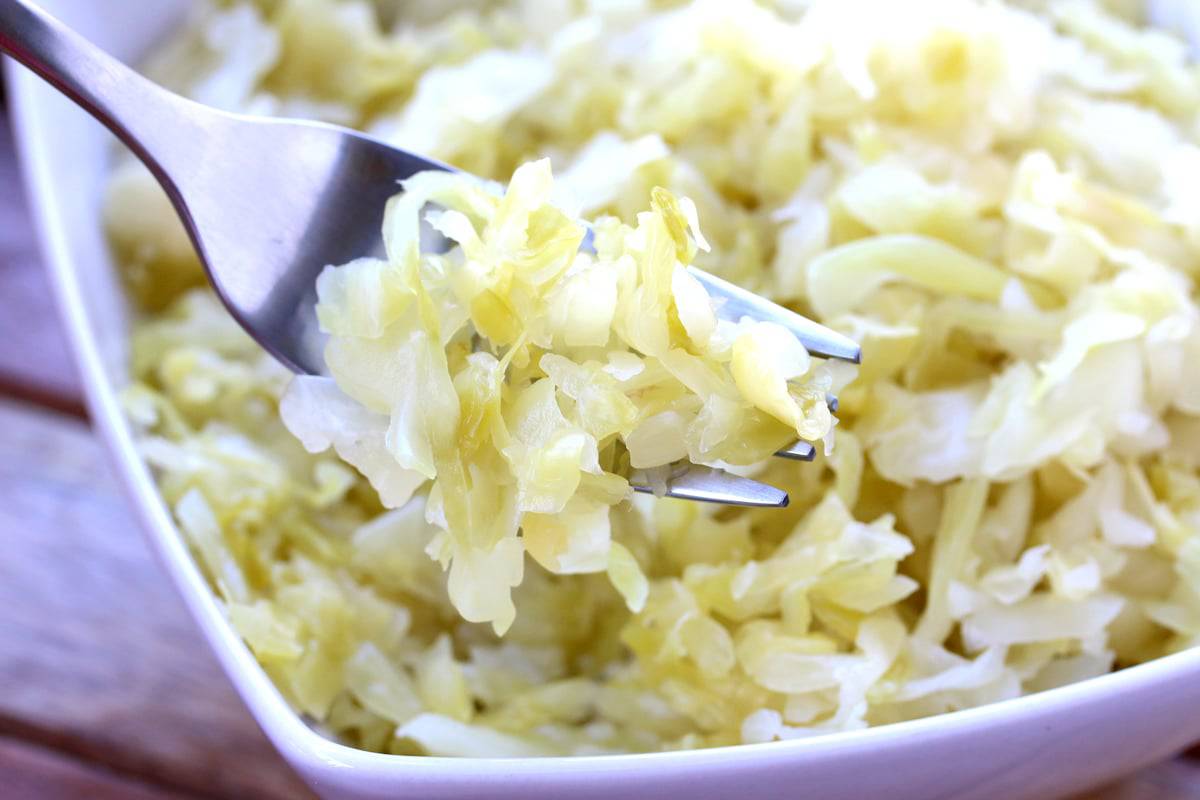
For sauerkraut recipe ideas be sure to try our:
Be sure to also check out our tutorials on:
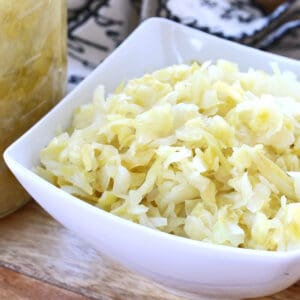
How to Make Sauerkraut
Ingredients
- 1 1/2-2 teaspoons salt for every pound of cabbage (9-12 grams salt per 450 grams of cabbage) (use sea salt or kosher salt - avoid iodized salt because it can inhibit fermentation and make sure that whatever salt you use contains no anti-caking ingredients)
- very fresh green cabbage (The fresher the cabbage the more juice it will have to make a sufficient amount of brine. The finished sauerkraut will also have a much better texture.)
Instructions
- Prepare the Cabbage:Remove any bruised or damaged exterior leaves from the cabbage, then cut the cabbage in half and remove the core. Slice the cabbage very thinly, approximately 1/8 inch thick. For the best texture we recommend slicing it very thinly by hand, not with a food processor. You can slice it by hand, use a mandolin, or cabbage slicer.Place the sliced cabbage in a large bowl and toss in the salt. Let it sit for about 20 minutes until the cabbage has begun to wilt and releases some of its juices. Use a tamper/pounder to crush the cabbage until it is wilted and has released a lot of liquid. This will takes several minutes.
- Pack the Cabbage in a Crock or Jar:Transfer the cabbage and all the juices to a glass or ceramic jar or crock a bit at a time and mash it down with a tamper. Fill the jar to about 2/3 full (the cabbage will bubble as it ferments and could overflow if the jar is too full).Continue to mash the cabbage with the tamper, releasing more juice, until the cabbage is completely submerged under the brine and any air pockets have been removed (important for preventing mold growth). If you've mashed all you can mash and you still don't have enough brine to cover the cabbage you'll need to make some supplemental liquid that is consistent with the salinity of the cabbage brine: Dissolve 1 teaspoon salt in 1 cup water (a 2% solution of salt water) and add that to the jar until the cabbage is completely submerged under the liquid.It is imperative that the cabbage remain submerged under the brine during fermentation, otherwise mold will form (See blog section "My Sauerkraut Has Mold on it: Is it Safe to Eat?"). To do this choose a heavy object whose diameter is roughly the same size to the inside of the crock you're using. The object should be glass, ceramic, or non-reactive metal.Note: I have made sauerkraut multiples times in large mason jars (usually 1/2 gallon size but you can use smaller jars) without needing to use a weight. Because of the small diameter of the jar, after a day or two of fermenting the cabbage usually remains below the liquid level. If the cabbage rises above it I just mash it back down with the tamper. If you choose to use mason jars without using something to weigh down the cabbage, just be sure to keep a close eye on it each day throughout the fermentation process.Screw on the lids to fingertip tightness (this is important to prevent exploding jars!). If using airlock lids, follow the instructions provided.
- Ferment Your Sauerkraut:Place the jars in a dark place that is between 65-70 degrees F, the ideal temperature for fermenting. (See blog section "How Long Does it Take to Ferment Sauerkraut" for information on temperature variations.)At a the ideal temperature range of 65-70 F we recommend fermenting the cabbage for at least 2 weeks (we recommend longer) but follow your own taste.After 4 days of fermenting start tasting the cabbage daily until it reaches the desired texture and level of tanginess. Don't be alarmed if the brine becomes fizzy, this is completely normal and a positive sign of microbial activity.Note: If you're not using an airlock lid be sure to open the lid of your jar/crock every day to release the pressure and prevent your jar from exploding. The color of the cabbage will change from green to a pale yellowish beige.
- Store Your Sauerkraut: Once your sauerkraut has reached the level of tanginess that you want, it's time to screw the lid on tight (remove the airlock lid if using and replace it with a regular lid).Store the sauerkraut in the fridge or a cold cellar (storage temperature should be between 38-50 degrees F). Fermentation won't stop but it will be greatly slowed down. Stored in the fridge the sauerkraut will keep for many months. (See blog section "Does Sauerkraut Go Bad?") If your sauerkraut is too salty for your taste simply give it a rinse before eating. Eat your sauerkraut raw to reap the benefits of the probiotics or use it in any recipe calling for sauerkraut.
Originally published on The Daring Gourmet January 2, 2021
Steve Mauran says
Hello Kimberly,
I am at the two week mark in a 1 gallon jar with lid and airlock, 3/4 full of cabbage and it looks like my brine disappeared. What should I do to make and add additional brine to my batch? Thanks!
Kimberly @ The Daring Gourmet says
Hi Steve, dissolve a teaspoon of salt in a cup of water (you can double this if needed) and pour it over your kraut.
Jay says
Hello Kimberly,
I normally have kraut perking most of the time. I use it mostly in salads. I use a 2 liter Fido jar, cabbage leaves to cover and Sauer Stones to hold it all under the liquid. I shoot for about 4 to 4-1/2% brine. It’s lasted over a year in the fridge. I normally make it with home grown bay leaves and juniper berries. I’ve never had a failure.
I can’t imagine living without it.
— jay
Kimberly @ The Daring Gourmet says
Thanks so much for that feedback, Jay. And it’s funny you mention home grown bay leaves, I’m still using the ones I dried from a huge bush I grew from a tiny start in my previous garden. I miss that bush but will be starting a new one here shortly.
Janet says
I bought a fermenting jar from temu. What can I use to weight down, when the opening is smaller than the flared out jar?
Next, can I just add the brine from my Clausen dill pickles? If so how much and when
Ralph says
Hi Kimerly,I have a 25 gallon crock that I have been making krout in for about 40 years.I pound it in layers,every 3rd layer I sprinkle a tsp of sugar,the head of my pounder is 4″with a 30″ handle, which makes it a lot easier to compress the cabbage, try the sugar trick on a batch, you will be amazed.
Kimberly @ The Daring Gourmet says
Thanks for the tip, Ralph, I’ll have to try it!
Dorothy Powell says
This is a excellent recipe . I have made several time in glass mason jars . Nice to be able to control the small amount when processing .
Kimberly @ The Daring Gourmet says
Thank you very much for the feedback and compliment, Dorothy, I appreciate it and am so glad it’s been a success!
Anonymous says
Love this recipe, easy and delicious. I have my entire family making sauerkraut now using this recipe!
Anne Stolitza says
My sauerkraut has been fermenting 3 weeks, it doesnt smell right and the liquid has become milky. Should I throw it out and start again?
Kimberly Killebrew says
Hi Anne, cloudy/milky brine is typically not a problem and if you look up that question online you’ll see it’s very common. The smell on the other hand…. Is this your first time making sauerkraut? The smell of fermenting sauerkraut can be off-putting if it’s something you’re not used to or if you don’t know what to expect. But either way though, if it smells “bad” to you I would trust your intuition and start over.
cHARLES says
if i can this, how long do you think it will last at 70 degrees f ?
Carrie W says
I use your recipe as my base method but have adapted a bit to my personal setup. 1. I use my hands to take get in there to squeeze the cabbage and make the cabbage liquid brine. Plus my kiddo thinks it is fantastic and loves to help do it. 2. I use one of the outer leaves, folded to size, to put under my glass weight. Works like a charm to keep the floaties down. 3. I use my mojito muddler to pack the jars tight. Lol! 4. I use a fermenting lid that lets air out, but not in. Love it! 5. I put my jar on a plate when it goes on the counter to ferment because it’ll leak a bit with the lid I use. Saves from cleaning up messes.
Kimberly Killebrew says
Fantastic, Carrie, thanks so much for the feedback! Mashing the cabbage with your hands is good therapy (and free, lol!) and great choice with the mojito muddler, especially for smaller jars!
Enzo Paduano says
Hi. I made this recipe using kosher salt. I had to add lots of extra brine as mashing the cabbage didn’t yield nearly enough. After 3 days fermentation still hasn’t started, so I drained all the original brine and made new brine, using sea salt this time. Is this okay?
Kimberly Killebrew says
Hi Enzo, fermentation can take considerably longer depending on the ambient temperature. Draining the original brine will just slow things down even further as the healthy bacteria was slowly developing in the brine but now the clock has largely started over. Kosher vs sea salt – either of those are perfectly fine. Your batch should still be fine, just wait patiently this time :)
Kim Suzanne says
Thank you for this recipe! It came out wonderful. I will make it again as I love the crunch of this sauerkraut as well as I can customize it to the tanginess that I prefer.
Kimberly Killebrew says
Thank you, Kim, I’m so glad it was a success!
Dawn Ryckman says
When the sauerkraut has finished fermenting, I transfer it into a mason jar for storage in the refrigerator. There is liquid leftover. Can I use this leftover liquid in my next batch of sauerkraut, as brine if more is needed to cover the cabbage?
Kimberly @ The Daring Gourmet says
You sure can, Dawn. As a “starter culture” it will also speed up the fermenting process.
Ann says
I haven’t made this yet but will be soon. I have a question, can I use Maccona coffee jars for the fermentation?
Kimberly @ The Daring Gourmet says
You bet, Ann. Any glass or ceramic jars will do the job.
Juana Gonzalez says
I have mold, in my sauerkraut do I need to throw away? I can I do?? Thanks
Kimberly @ The Daring Gourmet says
Hi Juana, that’s a very normal thing to happen during the fermentation process. It happens when the cabbage isn’t completely covered with liquid. Most people (myself included) feel perfectly comfortable discarding the top layer with the mold as long as the mold is white, grayish or greenish. If it’s black, pink, red or orange, I would toss the batch.
Barbara says
When should caraway seeds be added ?
Kimberly @ The Daring Gourmet says
Hi Barbara, add them right at the beginning so the flavor can develop while the sauerkraut is fermenting.
Matt says
Best sauerkraut I’ve ever had in my life. Ingredients: cabbage, salt, and nothing else.
Kimberly @ The Daring Gourmet says
That’s fantastic, Matt, I’m so glad it was a success – thank you!
Donna R Feuillet says
How much salt to 30 lbs of cabbage
Kimberly @ The Daring Gourmet says
Hi Donna, it’s 1 1/2 to 2 teaspoons per pound of cabbage so at the low end you’ll need 45 teaspoons which is just 3 teaspoons shy of 1 cup of salt.
Brigitte says
Trying this with my red cabbage and pink sea salt. Looking good so far!
Bolen Coogler says
If you have a kitchen scale, you can also measure out your salt by weight. This is more accurate than measuring spoons. An ounce of salt is an ounce of salt, whether it’s fine ground or coarse ground.
Aim for 2-3% salt by weight. I usually shoot for 2.25%. Call it “low(er) sodium.” :-)
For 30 pounds of cabbage: 30 x 16 x .0225 = 10.8 ounces of salt. If your scale can switch to metric, 10.8 ounces is 306 grams. I find it easier to use metric when measuring by weight.